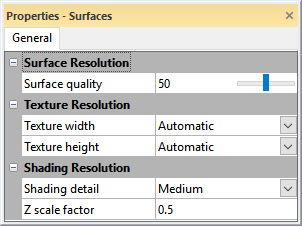Surfaces Group General Properties
The General page contains the surface and texture resolution properties for all surfaces in the 3D view. Select the Surfaces group in the 3D view Contents window to modify the resolution of the surfaces and textures. Increase the surface and texture resolution to improve the appearance of the map. Decrease the surface and texture resolution to increase the drawing speed in the 3D view.
|
|
|
Set the surface and texture appearance in the General page. |
Surface Resolution
The Surface quality property in the Surface Resolution section controls the quality of the surfaces in the 3D view. As the Surface quality is increased, more vertices are included in the surfaces in the 3D view. When Surface quality is set to 100, the surface is displayed at the full grid resolution. When the Surface quality is 50, half as many vertices in the X and Y directions are used to display the surface, i.e. the number of vertices is one-fourth the number of grid nodes. When Surface quality is set to 0, the minimum resolution is used to display the surface.
When the Surface quality is less than 100, overlaid texture contour lines may appear to vary in elevation on the surface. If your computer is capable of rendering the surface at full resolution, a Surface quality of 100 is recommended when the surface in the 3D view includes a contour layer texture overlay.
Texture Resolution
The Texture Resolution properties control the appearance of the surface overlay textures. The Texture width is the number of pixels used to render the texture overlays in the X direction. The Texture height is the number of pixels used to render the texture overlays in the Y direction.
The Texture width and Texture height can be specified independently to account for different surfaces. For surfaces that are generally square, the Texture width and Texture height should be set to the same value. For surfaces that are rectangular, i.e. one side is significantly longer than the other, the texture appearance may be improved by increasing the resolution along the long side of the surface.
By default the Texture width and Texture height are set to automatic. When both Texture width and Texture height are set to Automatic, the surface resolution along the longer direction is set to 1024 and the surface resolution along the shorter side is set based on the ratio between the surface width and height. For example, a square surface will have 1024 pixels along the width and height while a long and skinny surface may only use 256 pixels along the shorter direction. When only one of the Texture width or Texture height values are set to Automatic, the Automatic value varies based on the specified value and the ratio between the surface width and height.
To change the Texture width or Texture height, select the desired resolution from the list. Select Automatic, 256, 512, 1024, 2048, 4096, 8192, or 16384 pixels.
Shading Resolution
The Shading Resolution properties control the amount and quality of the surface shading. The Shading detail specifies the amount of surface shading detail. The Z scale factor increases or decreases shading.
The Shading detail has three levels of shading quality:
- High increases the level of detail in the surface shading. High looks best for most surfaces, but consider lowering the level if your video card memory is limited.
- Medium is similar to the shading by the color relief layer, where some shading information is visible at every grid node.
- Low is best for computers with little memory or when displaying low resolution grids in the 3D view.
The Z scale factor property sets the Z scale to use for the surface. As you increase the Z scale factor, the surface becomes more exaggerated vertically. Increasing the factor enhances the shading effect, and can be useful for bringing out more detail, especially on relatively flat surfaces.
